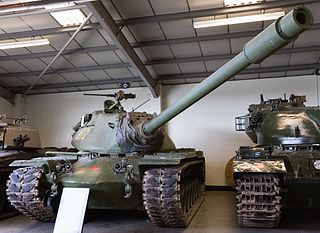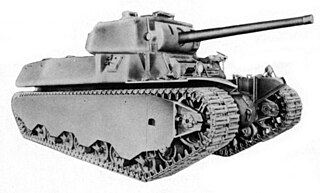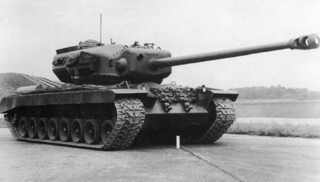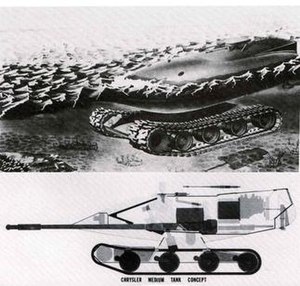
The M1 Abrams is a third-generation American main battle tank designed by Chrysler Defense and named for General Creighton Abrams. Conceived for modern armored ground warfare and now one of the heaviest tanks in service at nearly 68 short tons, it introduced several modern technologies to United States armored forces, including a multifuel turbine engine, sophisticated Chobham composite armor, a computer fire control system, separate ammunition storage in a blowout compartment, and NBC protection for crew safety. Initial models of the M1 were armed with a 105 mm M68 gun, while later variants feature a license-produced Rheinmetall 120 mm L/44 designated M256.

The M26 Pershing is a heavy tank/medium tank formerly used by the United States Army. It was used in the last months of World War II during the Invasion of Germany and extensively during the Korean War. The tank was named after General of the Armies John J. Pershing, who led the American Expeditionary Force in Europe in World War I.

The MBT-70 was an American–West German joint project to develop a new main battle tank during the 1960s.

The M3 Lee, officially Medium Tank, M3, was an American medium tank used during World War II. The turret was produced in two forms, one for US needs and one modified to British requirements to place the radio next to the commander. In British Commonwealth service, the tank was called by two names: tanks employing US-pattern turrets were called "Lee", named after Confederate general Robert E. Lee, while those with British-pattern turrets were known as "Grant", named after Union general Ulysses S. Grant.

Panzerkampfwagen VIII Maus was a German World War II super-heavy tank completed in late 1944. It is the heaviest fully enclosed armored fighting vehicle ever built. Five were ordered, but only two hulls and one turret were completed, the turret being attached before the testing grounds were captured by advancing Soviet military forces.

The M48 Patton is an American first-generation main battle tank (MBT) introduced in February 1952, being designated as the 90mm Gun Tank: M48. It was designed as a replacement for the M26 Pershing, M4 Sherman, M46 and M47 Patton tanks, and was the main battle tank of the U.S. Army and U.S. Marine Corps in the Vietnam War. Nearly 12,000 M48s were built, mainly by Chrysler and American Locomotive Company, from 1952 to 1961. The M48 Patton was the first U.S. medium gun tank with a four-man crew, featuring a centerline driver's compartment and no bow machine gunner. As with nearly all new armored vehicles it had a wide variety of suspension systems, cupola styles, power packs, fenders and other details among individual tanks.

The M60 is an American second-generation main battle tank (MBT). It was officially standardized as the Tank, Combat, Full Tracked: 105-mm Gun, M60 in March 1959. Although developed from the M48 Patton, the M60 tank series was never officially christened as a Patton tank. The US Army considered it a "product-improved descendant" of the Patton tank's design. The design similarities are evident comparing the original version of the M60 and the M48A2. It has been sometimes informally grouped as a member of the Patton tank family. The United States fully committed to the MBT doctrine in 1963, when the Marine Corps retired the last (M103) heavy tank battalion. The M60 tank series became America's primary main battle tank during the Cold War, reaching a production total of 15,000 M60s. Hull production ended in 1983, but 5,400 older models were converted to the M60A3 variant ending in 1990.

The M18 Hellcat is a tank destroyer used by the United States Army in World War II and the Korean War. Despite being equipped with the same main gun as some variants of the much larger Sherman tank, the M18 attained a much higher top speed of up to 55 mph (89 km/h) by keeping armor to a minimum, and using the innovative Torqmatic automatic transmission.

The M103 Heavy Tank was a heavy tank that served in the United States Army and the United States Marine Corps during the Cold War. Introduced in 1957, it served through 1974, by which time evolution of the concept of a main battle tank considered heavy tanks obsolete.

The M10 tank destroyer, formally 3-inch Gun Motor Carriage M10, or M10 GMC was an American tank destroyer of World War II. After US entry into World War II and the formation of the Tank Destroyer Force, a suitable vehicle was needed to equip the new battalions. By November 1941, the Army requested a vehicle with a gun in a fully rotating turret after other interim models were criticized for being too poorly designed. The prototype of the M10 was conceived in early 1942 and delivered in April that year. After appropriate changes to the hull and turret were made, the modified version was selected for production in June 1942 as the "3-inch Gun Motor Carriage M10". It mounted the 3-inch gun M7 in a rotating turret on a modified M4 Sherman tank chassis.

The M8 light armored car is a 6×6 armored car produced by the Ford Motor Company during World War II. It was used from 1943 by United States and British forces in Europe and the Pacific until the end of the war. The vehicle was widely exported and as of 2006 still remained in service with some countries.
An autoloader or auto-loader is a mechanical aid or replacement for the personnel that load ammunition into crew-served weapons without being an integrated part of the gun itself. The term is generally only applied to larger weapons, such as naval weapons, tanks, and artillery; that would otherwise have a dedicated person or persons loading them.

The Heavy Tank T30 was a World War II American tank project developed to counter new German tanks, such as Tiger I, Tiger II, and tank destroyers, such as the Jagdtiger, or Soviet heavy tanks, such as IS-2 or IS-3. The T30 was designed at the same time as the T29 Heavy Tank.

The Heavy Tank M6 was an American heavy tank designed during World War II. The tank was produced in small numbers and never saw combat.

The Heavy Tank T29 was an American heavy tank project started in March 1944 to counter the appearance of the German Tiger II heavy tank. The T29 was not ready in time for the war in Europe, but it did provide post-war engineers with opportunities for applying engineering concepts to artillery and automotive components.

United Shoe Machinery Corporation (USMC) was a U.S.-based manufacturer of various industrial machinery, particularly for the shoe manufacturing industry and monopolized the American shoe machinery business. It was an important federal government's defense contractor during the World War I, Interbellum years, World War II and the Cold war era, which developed and manufactured various land and aircraft armaments, as well as components for the military hardware made by other manufacturers. Founded in Beverly, Massachusetts, its corporate headquarters were eventually relocated to Boston, with key production facilities scattered around Massachusetts. It had subsidiaries in other countries including British United Shoe Machinery in England.
The M1 Abrams main battle tank has been in service since 1980. Since then, it has gone through dozens of upgrades and been the baseline variant of several vehicles.

The Light Tank, T1, was a United States Army light tank of the late 1920s and early 1930s that was only built in prototype form. The tank was an Army design built by James Cunningham, Son and Company. Introduced in 1927, it was developed up through 1932 as a series of modified versions. The tank was never mass-produced, nor was it ever used in combat.

The ELC project was a prototype light tank project launched by the French Ministry of Defense in 1955. The purpose of the ELC project was to develop a lightly armoured, heavily armed fighting vehicle capable of being airlifted for rapid deployment.
The Obiekt 490 "Poplar", or Object 490, was an experimental Soviet tank developed in the early 1980s. Two versions of the vehicle existed under the same project name, however the designs were radically different, with the second being one of the most unusual designs in the history of tank development. The vehicle was designed by Eugenie Morozov, who was the son of Alexander Alexandrovich Morozov. The project was cancelled in 1991 following the collapse of the USSR and Morozov's death.

















